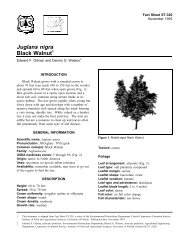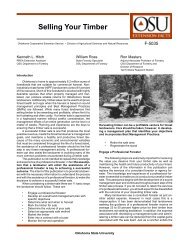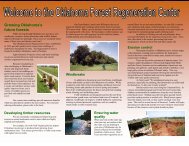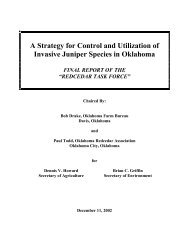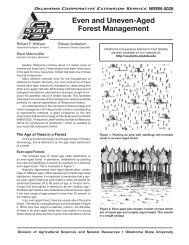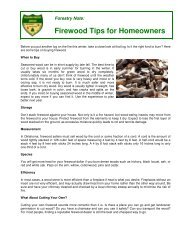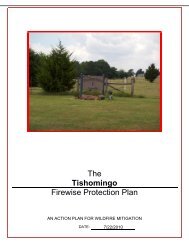Common Diseases of Conifers in Oklahoma - OSU Fact Sheets ...
Common Diseases of Conifers in Oklahoma - OSU Fact Sheets ...
Common Diseases of Conifers in Oklahoma - OSU Fact Sheets ...
Create successful ePaper yourself
Turn your PDF publications into a flip-book with our unique Google optimized e-Paper software.
Figure 1. Dothistroma needle blight on Austrian p<strong>in</strong>e.ControlSeedl<strong>in</strong>gs and young trees that are <strong>in</strong>fected with the stemrot phase cannot be treated successfully. When Diplodia TipBlight has been a problem <strong>in</strong> seedl<strong>in</strong>g production, the use <strong>of</strong>steam-pasteurized soil or soil fumigants will help <strong>in</strong> controll<strong>in</strong>groot and stem <strong>in</strong>fection.Diplodia Tip Blight on older trees can be controlled byprun<strong>in</strong>g and sanitation. As soon as blighted term<strong>in</strong>als andcones are noticed, the needles, twigs and cones should bepruned to healthy tissue and destroyed. Do not prune whenthe branches are wet because the conidia <strong>of</strong> the fungus caneasily be spread when moisture is present. Where <strong>in</strong>fectionhas been severe, the use <strong>of</strong> Bordeaux mixture or CopperFungicide 4E will control this disease. It should be appliedearly <strong>in</strong> the spr<strong>in</strong>g, when the buds open, and twice more atweekly <strong>in</strong>tervals until the needles break through the needlesheaths. An application <strong>of</strong> fungicide <strong>in</strong> the fall may also aid<strong>in</strong> slow<strong>in</strong>g the spread <strong>of</strong> the disease; however, fertilizationand water<strong>in</strong>g <strong>in</strong> the fall may be more beneficial. Homeownerswho ma<strong>in</strong>ta<strong>in</strong> vigorous trees through good tree health carewill have fewer problems with Diplodia Tip Blight.Needle CastsSymptomsThe first <strong>in</strong>dication <strong>of</strong> this tree disease is the scorchedbrown or yellowish appearance <strong>of</strong> most <strong>of</strong> the needles. Manyp<strong>in</strong>es are affected by this disease and it can become a severeproblem <strong>in</strong> Christmas tree plant<strong>in</strong>gs. The <strong>in</strong>itial discoloration <strong>of</strong>the needles is followed by needle fall or cast<strong>in</strong>g. Few trees areactually killed by this defoliation but susta<strong>in</strong>ed needle kill willeventually reduce the overall growth rate and make the treemore susceptible to other diseases and <strong>in</strong>sect attack. Over40 different species <strong>of</strong> fungi are capable <strong>of</strong> caus<strong>in</strong>g needlecase. The more important ones are Lophodermium p<strong>in</strong>astri,Hypoderma lethale, and Hypoderma hedgcockii.Disease CycleSmall black elliptical fruit<strong>in</strong>g bodies <strong>of</strong> the fungus areproduced on the needles. These structures break open <strong>in</strong> thelate spr<strong>in</strong>g or early summer dur<strong>in</strong>g periods <strong>of</strong> wet weather andrelease great numbers <strong>of</strong> spores. The spores can be spreadby splash<strong>in</strong>g ra<strong>in</strong> or w<strong>in</strong>d to <strong>in</strong>fect other needles or trees.Figure 2. Stunted term<strong>in</strong>al branch <strong>of</strong> p<strong>in</strong>e <strong>in</strong>fected withDiplodia p<strong>in</strong>ea.Infected needles beg<strong>in</strong> to turn brown dur<strong>in</strong>g the late fall andearly spr<strong>in</strong>g and will have a mottled appearance due to thedeath <strong>of</strong> needle tissue at the <strong>in</strong>fection sites. Temperature andhumidity are very important <strong>in</strong> determ<strong>in</strong><strong>in</strong>g the severity <strong>of</strong> the<strong>in</strong>fection.ControlIn nurseries this disease can be controlled by the application<strong>of</strong> the fungicide after the needles are half grown followedby a second application when the needles are fully developed.No chemical control measures are normally recommendedfor homeowners even though the tree may appear unsightly.Collection <strong>of</strong> <strong>in</strong>fected needles and their destruction will greatlyreduce this disease. However, if a homeowner wishes tocontrol this disease, the proper application <strong>of</strong> a fungicide willprovide excellent control.Phomopsis Blight <strong>of</strong> JunipersThis is the most common disease <strong>of</strong> cedar, juniper, andarborvitae <strong>in</strong> <strong>Oklahoma</strong>. Phomopsis Blight can be a severeproblem <strong>in</strong> nursery plant<strong>in</strong>gs and can cause the death <strong>of</strong> manyseedl<strong>in</strong>gs. Older trees are less affected by Phomopsis Blightand unless these trees are environmentally stressed or <strong>in</strong>poor health they are usually not affected enough to warrantchemical sprays.Symptoms and Disease CycleInfected trees will exhibit brown<strong>in</strong>g <strong>of</strong> the foliage and dy<strong>in</strong>g<strong>of</strong> twigs and branches (Figure 4). Small black fruit<strong>in</strong>g bodies <strong>of</strong>the fungus, Phomopsis juniperovora, are formed on this deadtissue. Conidia are produced <strong>in</strong> these structures and whenmoisture is present masses <strong>of</strong> conidia will ooze out to formtendrils or horns. The conidia are spread by ra<strong>in</strong> and variousother means such as mechanical disruption and <strong>in</strong>sects. Thefungus enters the plant through wounds as well as unbrokentissue. The brown<strong>in</strong>g <strong>of</strong> the needles and twigs beg<strong>in</strong>s at thetips and progresses downward toward the stem. Moisture isan important factor <strong>in</strong> disease spread and severity. Nurseriesand Christmas tree plantations that utilize overhead irrigation7618-2



